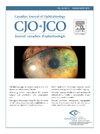一项基于smile的晶状体贴片植入的初步研究:各种角膜病变的基质增强。
IF 2.8
4区 医学
Q1 OPHTHALMOLOGY
Canadian journal of ophthalmology. Journal canadien d'ophtalmologie
Pub Date : 2025-10-01
DOI:10.1016/j.jcjo.2025.03.014
引用次数: 0
摘要
目的:评价小切口晶状体摘除术(SMILE)衍生的晶状体贴片移植治疗角膜缺损的初步临床效果。方法:回顾性分析2016年至2020年在2家不同的三级转诊医院接受smile衍生透镜体贴片缝合线植入的患者。评估病因、最小分辨角对数(logMAR)-等效最佳矫正视力(BCVA)和眼球完整性。记录额外的手术干预和二次手术。随访时间为1年。结果:16例患者16只眼(女9例,男7例)纳入研究。患者平均年龄48.9±19.6岁(24 ~ 80岁)。最常见的潜在病因是神经营养性角膜炎(18.7%)、穿透性损伤(18.7%)和炎症或风湿病引起的角膜融化(18.7%)。病因不明者4例(25.0%)。手术后16只眼的角膜完整性均获得解剖上的成功。术前平均logMAR BCVA为1.9±0.8,术后平均logMAR BCVA为1.2±0.7。3例患者行羊膜移植,同时行小泡贴片。术后,4例(25.0%)患者行穿透性角膜移植术以改善BCVA。结论:应用晶状体贴片治疗各种角膜病变继发性角膜缺损,能有效、可靠地保护眼的完整性。这种方法对于在角膜供体组织可用之前无法在紧急情况下进行角膜移植的患者特别有利。本文章由计算机程序翻译,如有差异,请以英文原文为准。
A pilot study on SMILE-derived lenticule patch implantation: stromal augmentation for various corneal pathologies
Objective
To evaluate the initial clinical outcomes of a small-incision lenticule extraction (SMILE)-derived lenticule patch graft for the management of corneal defects.
Methods
Patients who underwent SMILE-derived lenticule patch graft implantation with sutures between 2016 and 2020 at 2 different tertiary-care referral hospitals were evaluated retrospectively. The etiology, logarithm of the minimum angle of resolution (logMAR)-equivalent best corrected visual acuity (BCVA), and globe integrity were evaluated. Additional surgical interventions and secondary surgeries were recorded. The follow-up duration was 1 year.
Results
Sixteen eyes of 16 patients (9 females and 7 males) were included in the study. The mean age of the patients was 48.9 ± 19.6 (range: 24–80) years. The most common underlying etiologies were neurotrophic keratitis (18.7%), penetrating injuries (18.7%), and corneal melting due to inflammatory or rheumatological disorders (18.7%). The etiology was unknown in 4 patients (25.0%). Anatomic success in terms of corneal integrity was achieved in all 16 eyes after the procedure. The mean logMAR BCVA was 1.9 ± 0.8 before the surgery and 1.2 ± 0.7 after the surgery. In 3 patients, amniotic membrane transplantation was performed together with a lenticule patch. After the procedure, penetrating keratoplasty was performed in 4 patients (25.0%) to improve their BCVA.
Conclusions
Lenticule patch application to treat corneal defects secondary to various corneal pathologies is effective and reliable for preserving eye integrity. This method is particularly advantageous for patients unable to undergo a cornea transplant under emergency conditions until cornea donor tissue becomes available.
求助全文
通过发布文献求助,成功后即可免费获取论文全文。
去求助
来源期刊
CiteScore
3.20
自引率
4.80%
发文量
223
审稿时长
38 days
期刊介绍:
Official journal of the Canadian Ophthalmological Society.
The Canadian Journal of Ophthalmology (CJO) is the official journal of the Canadian Ophthalmological Society and is committed to timely publication of original, peer-reviewed ophthalmology and vision science articles.

 求助内容:
求助内容: 应助结果提醒方式:
应助结果提醒方式:


